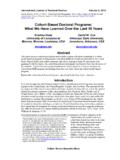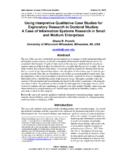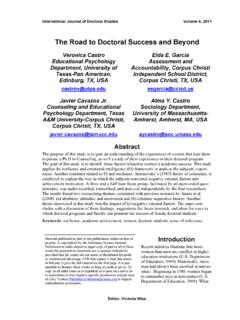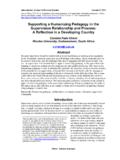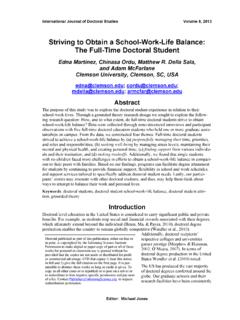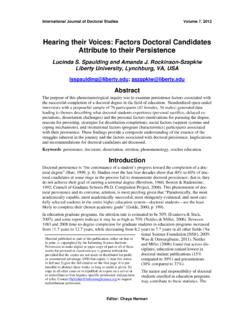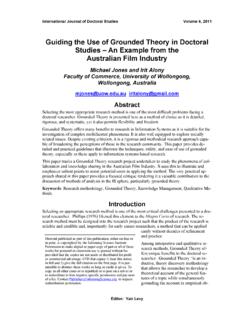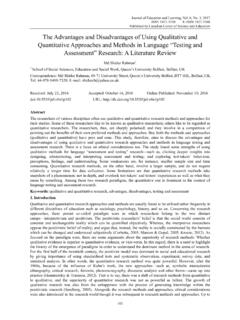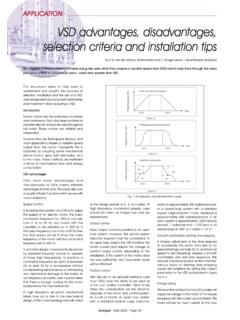Transcription of Delphi Panels: Research Design, Procedures, Advantages ...
1 International Journal of Doctoral Studies Volume 11, 2016. Cite as: Avella, J. R. (2016). Delphi panels : Research design , procedures , Advantages , and challenges. International Journal of Doctoral Studies, 11, 305-321. Retrieved from Delphi panels : Research design , procedures , Advantages , and Challenges Jay R. Avella University of Phoenix, Tempe, Arizona, USA. Abstract Among the typical dissertation Research designs, one particular design that is slowly gaining ac- ceptance is that of the Delphi Method. Using a panel of experts to achieve consensus in solving a problem, deciding the most appropriate course of action, or establishing causation where none previously existed, particularly in areas of business or education Research , are uniquely ideal to employment of the design . This article reviews the origins of the method, provides detail on as- sembling the panel and executing the process, gives examples of conventional and modified Del- phi designs, and summarizes the inherent Advantages and disadvantages that the design brings.
2 The article closes with some advice for those contemplating its use in their dissertations. Keywords: Delphi , consensus, dissertation Research , problem-solving, expert panel, critique Introduction Qualitative Research designs come in many forms, with the case study perhaps the most frequent- ly employed in doctoral dissertations. (Calendar year 2014/2015 abstract statistics reflecting dis- sertation Research designs indicated almost 9,500 case studies, with the over 1,250 grounded theo- ry studies the next most frequently indicated.) Others employed less frequently include phenome- nology, ethnography, and narrative inquiry. One design that is becoming increasingly popular among student qualitative researchers pursuing their dissertations is that of the Delphi Method. This article traces how it came about, discusses elements of the design and its execution, provides examples of different types of the design , and articulates Advantages and disadvantages .
3 The method takes its name from the ancient Greek city that housed the oracle. There, a priest- ess (called the Pythia ) purportedly communicated directly with the gods and would answer questions (deBoer & Hale, 2002). This more recent Delphi was developed by the Rand Corpora- tion under government contract in the 1950s as a method to forecast likely outcomes from nuclear weapons usage in war. Norman Dalkey and Olaf Helmer, two Rand mathematicians, de- veloped the method and their approach was based on two key principles and the need to compensate for both of them (Dalkey & Helmer, 1963). This article has been copyrighted by the Informing Science Institute on behalf of its authors. We license it First, when it came to forecasting, there were two to you under a Creative Commons Attribution- extremes on which individual predictions were typi- NonCommercial International License. When you cally based.
4 On the one end was knowledge, which copy and redistribute this paper in full or in part, you need to provide proper attribution to it to ensure that was based on evidence, and the other was specula- others can later locate this work (and to ensure that tion, which lacked any evidence and was basically others do not accuse you of plagiarism). You may an educated guess. In between was opinion, (and we encourage you to) adapt, remix, transform, and build upon the material for any non-commercial which was the result of an individual's integration purposes. This license does not permit you to use this of the two extremes (Dalkey & Helmer, 1963). material for commercial purposes. Editor: Matthew Kemp Submitted: January 12, 2016; Revised: May 22, June 28, July 26, August 12, 2016;. Accepted: September 9, 2016. Delphi panels Second, face-to-face group discussions where participants voiced individual opinions and arrived at a collective conclusion were often less accurate than the opinions of individuals when averaged without discussion (Dalkey & Helmer, 1963).
5 Scholars and students of group dynamics know that dominant individuals can control the conversation and, in that way, eventually the outcomes. The one who speaks out loud and often can prevail over the group, even though that individual may not be the most knowledgeable (Fischer, 1978). When one combines that with the pressure for conformity that often exists within a group, characterized as groupthink by Janis (1982), it is no wonder this difference in accuracy resulted. Neither would have affected an average without dis- cussion outcome (Fischer, 1978). Dalkey and Helmer's method and approach provided a foundation for what has since become known as futures Research (Von der Gracht, 2008). By using subject matter experts in an anon- ymous environment and bypassing those weaknesses found in meetings and conferences, re- searchers have been able to accurately forecast the development of a number of things that have since become components of everyday life.
6 Among these were oral contraceptives, organ trans- plants, synthetic proteins, ultralight materials, and the economic desalinization of sea water (Amant, 1970). And while a manned landing on Mars was not considered feasible in 1970 (called a miss by Amant), NASA has a very different viewpoint today. The Delphi design falls under the general category of consensus development techniques, . which in turn are under the general grouping of action Research approaches (Vernon, 2009). Con- sensus techniques are typically applicable when there is limited evidence or when the existing evidence is contradictory in the specific topic of interest. Delphi itself is uniquely applicable in areas where there is little prior Research or where advantage could be realized in the collective subjective judgment of experts (Hejblum et al., 2008). It has also been applied in large, complex problems plagued with uncertainty and in situations where causation can't be established (Yang, Zeng, & Zhang, 2012).
7 Delphi is predominantly qualitative in nature, but it can have a quantitative component depending on the specific application. As such, its primary characteristics match those of interpretivism. Ex- amples of qualitative-only and partially quantitative strategies are presented later in this paper. The Delphi Panel Process design Overview The basic design involves assembling groups of experts without concern for geography, and who then reply to a number of rounds involving response to a specific question or questions through e-mail (Linstone & Turoff, 2002). After each round, participants receive feedback of the group response which typically takes the form of points of agreement listed in order of most- to least- often mentioned. Historically speaking, the Delphi method falls into one of three versions which differ by their purpose. A Policy Delphi is used when there is a need to devise a strategy to address a specific problem; a Classical Delphi is used to forecast the future; and, a Decision-Making Delphi is used to achieve better decision making.
8 While these design versions may differ in purpose, the execution of the design can take many different forms irrespective of the purpose. different ver- sions may execute the exact same or very different designs, depending on the specific study ob- jective, as will also be discussed later in this paper. The rounds process repeats itself with the goal of reducing the range of responses until consen- sus is achieved (Linstone & Turoff, 2002). With each repetition, specific responses would re- ceive increasing or decreasing mention, eventually being pared down to an outcome acceptable to 306. Avella all. It is worthwhile noting at this point that consensus does not mean 100% agreement, as it might be extremely difficult to get groups of individuals representing different constituencies with varying viewpoints and priorities to reach unanimity. Delphi consensus typically ranges from 55 to 100% agreement, with 70% considered the standard (Vernon, 2009).
9 Dalkey and Helmer found that early responses exhibited wide ranges of alternatives, but were quickly dis- tilled after very few iterations (Fischer, 1978). Role of the Researcher The role of the researcher is twofold: the first is that of planner, and later that of facilitator as opposed to instrument in the case of more traditional qualitative designs. In carefully designed and executed panels , the risk of researcher bias are minimal, if not nil, as the researcher's primary task is that of planner/coordinator/recorder, and the back-and-forth communication between re- searcher and panel members provides for internal process auditing. One should note that con- tributor appears nowhere in the responsibilities of a Delphi researcher. In planning a Delphi study, the principal tasks include identifying the discipline, number, and content of groups, and establishing the method and procedures of communication.
10 Given the evo- lution of communication technology in recent years, it is perhaps hard to imagine a Delphi study being conducted through the mail using written or typed documents, but there may be occasions when this might be necessary. Most, if not all, Delphi dissertation studies will be conducted using e-mail, and in certain, very rare circumstances, if feasible, panel members might be brought to- gether at the end to finalize the study outcomes. Melynk, Lummus, Vokurka, Bursm, and Sandor (2009) convened a Delphi panel consisting of supply chain managers and leading figures in sup- ply chain Research , with the objective to identify and prioritize the key issues and challenges fac- ing the discipline as it transitioned from a tactical business practice with focus on cost and deliv- ery, to one more strategic in nature where it became a point of differentiation from competitors. The panel established the priority list and later were invited to come together to discuss and ex- tend the findings.
